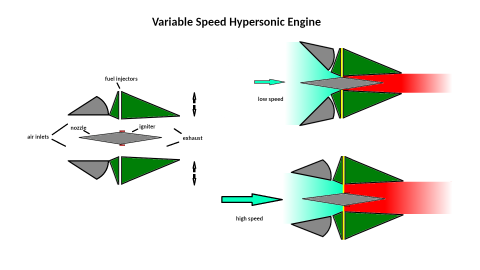
I would like to propose a new type of hypersonic jet engine: one capable of operating at variable speeds.
To begin with, a hypersonic engine is a way around the difficulties experienced by jet engines. A jet engine works by using its engine exhaust to turn turbines connected to the same shaft as its air intake, thereby compressing incoming air to the point where fuel can be injected into it and ignited, thereby creating yet more exhaust, etc, ad infinitum.
The problems with the jet engine are two-fold: first, it uses a great many moving parts, and creates a great deal of wear and tear that results in expensive repairs, as well as the potential for catastrophic air disasters.
Secondly, there is a theoretical maximum speed at which a jet engine can safely operate, beyond which air travel becomes impossible.
This is the dilemma for which hypersonic engines were first designed. At high enough speeds, air can be compressed by virtue of how fast the aircraft is moving, without the need for complex turbine mechanics.
However, this created a new problem: hypersonic engines were designed only for high speeds, which meant that to reach such a speed one would need to rely upon some form of conventional propulsion.
Some solutions involved using a rocket to propel the craft to speeds at which its hypersonic engines could then be engaged. This worked for military weapons such as missiles, which did not need to decelerate back to super or subsonic speeds before reaching their target. But craft that were not designed for one-way suicide missions, such as the piloted type, had no way of landing once they had reached hypersonic speeds.
In an attempt to address this problem, I have envisioned a hypersonic engine capable of sustained flight at variable speeds. The lower the speed, the narrower its air intakes, and the higher the speed, the wider its air intakes. Air speed can first be calculated, and then air intake width adjusted accordingly, allowing the compressed air to be properly injected with fuel and then ignited regardless of the craft's speed.
Of course, the only speed at which this system would not be able to operate would be a complete standstill. I do not propose any real solution to that problem, other than booster rockets, which are already in use in the field of avionics.
Add new comment